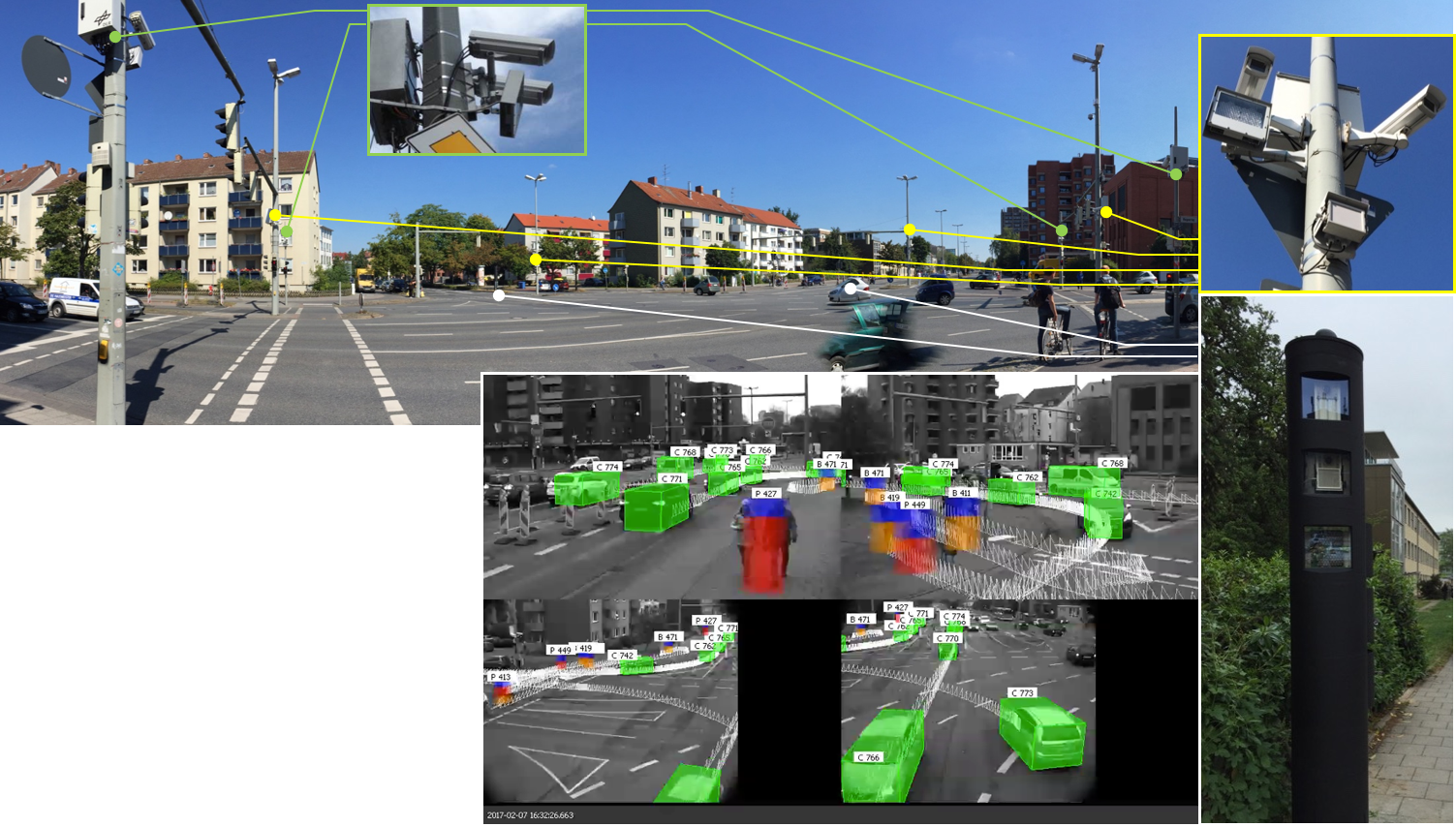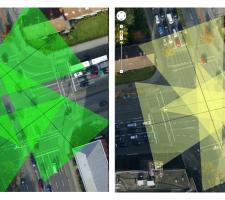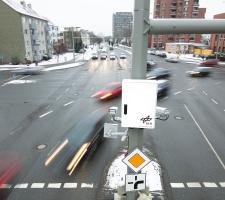
When considering the ideal sensing and monitoring system to enable the ITS sector to deliver improvements in mobility and road safety, for general policing security and border protection, we have to think beyond radar-base systems or laser scanners. What is needed today are solutions for detecting and tracking vehicles while recording evidence to deacide if any action is necessary. There is no sole sensor capable of capturing all the information needed in all conditions so the best option is to use the strengths and advantages of a combination of sensors and other components to achieve the required results.
At the same time it has to be clear that this is not meant to become a realised version of Nineteen Eighty-Four with Big Brother’s omnipresent surveillance of the public. On the contrary, the technology is used in a number of ways to assist road users, highway operators and the police
to deliver safer and more efficient journeys for all.
Sensor fusion
What was needed was a modular, multi-sensor (sensor fusion) and infrastructure-based object detection system which evaluates all information about traffic conditions and road users. Real-time measuring data can be collected by an optimised set of sensor technology (stereo cameras, ANPR camera with IR-illumination, radar and laser) tailored to the individual situation and requirements. Measurement accuracy of position and speed, detection rates, robustness to meet changing ambient conditions, including lighting, rainfall or snow and temperatures, are all influenced by the connection opportunities of different sensors with their respective strengths. Combining data from different sensors leads to 3D features which guarantee object detection, classification, tracking and positioning.
There is already action going on when it comes to the different modules offering features guaranteeing payment processes, access control, face recognition, ANPR, classification, monitoring and tracking or connection of variable message signs. Jenoptik already delivers modular, multi-sensor systems for the detection of passing vehicles, recording evidence, classification, number plate reading, axle counting, matching and exchanging of data. The key is knowing where to place the adequate components to achieve the intended result of a complex traffic task. This approach has to be balanced depending on the conditions and requirements, and uses decentralised components to collect all information. It also requires a larger footprint.
The roadside units capture data and typically send it to a back office system for evaluation. In addition, smart ANPR software solutions can help while interfacing real-time vehicle information with the operators’ data and objectives.
Capturing the roadside data typically involves a network of ALPR cameras, taking images of the licence plate along with an overview image showing the vehicle on the road. This data is then encrypted and partially or completely transferred to a central data server, depending on the application. Without analysing the captured data it is just raw information and its value is limited.
However, sophisticated data mining tools can allow the ALPR data to be accessed and it can be presented spatially, chronologically and statistically through intuitive use of maps, charts and graphs. This allows patterns of behaviour to be identified, making connections between events, locations, vehicles and people which would be virtually impossible to achieve by any other means. Through the ALPR capture and back office analysis, a detailed picture can be constructed of what is happening within the monitored zone.
Powerful and fully scalable back office solutions complete the portfolio of tools needed for recording and evaluating the collected data.
Such systems can be capable of receiving, processing and storing 6 million+ reads per day and for example, matching those against various Hotlists or evaluating moving patterns in real-time and sending alerts in case of action required. Bringing all this together provides a process chain that guarantees every danger, problem or obstacle can be identified and action taken to make journeys safe.
Sophisticated projects
Participation in research projects is often a prerequisite for the technology requirements when realising complex projects and the AIM (Application Platform for Intelligent Mobility) project in cooperation with the German Aerospace Centre is a good example. In AIM, an entire city serves as a platform for application-focused research and development in the field of intelligent mobility services. AIM consists of parts for observing and influencing traffic which are placed on dedicated test tracks, real urban areas and selected parts of the surrounding regions.One of AIM’s facilities is the Research Intersection - a platform for real-time detection, prediction and classification of motorised and non-motorised traffic participants at one of the most complex urban intersections in Brunswick, Germany. The technical set-up uses a number of different sensor technologies (Laser Scanner- or Radar-Mono/Stereo-Video Sensor Fusion).
A sub-system for detecting motorised traffic consists of mono-cameras, 24 Ghz radar systems and infrared spotlights. Four redundant installations are attached to different poles in the intersection in order to cover the whole inner area and prevent data loss due to covered scene details. A sub-system for detecting pedestrians and cyclists uses stereo-camera technology and monitors the cross-walks.
The main output of the system is trajectory data of the traffic participants with corresponding scene videos. These trajectories contain the objects’ positions in the scene and other relevant information including velocity, acceleration or specifications about the objects’ length and width. In combination with the given traffic light data, this output allows an overall understanding of the respective traffic situation.
Many such projects are already in progress in the Middle East and are being realised on the basis of an optimised combination of components. As Adel Agha, director of Jenoptiks’ Regional Competence Centre, stresses, “there is a great demand for bespoke solutions designed to meet the needs of the on-site infrastructure.” The latest section speed control (or average speed) project will be installed on one of the world’s largest maritime causeways, the 43km Sheikh Jaber Al-Ahmad Bridge between Kuwait City and Subiyah.
The installation uses a pair of laser scanners to trigger cameras covering each lane (three plus an emergency lane in each direction) at the entry and exit to each 4km section and to offer the possibility to classify the passing vehicles. Through the combination of the data streams of both scanners, a 3D model is generated for each passing vehicle and enables the system to differentiate between up to eleven different classes.
According to Adel Agha, the requirements of traffic authorities in the Middle East correspond well with the principles of modular and decentralised components. “There is also the actual infrastructure and the extremely varying traffic situations which have to be taken into account,” he says. Beyond speed and red light enforcement, solutions such as ANPR, tailgaiting, illegal turning, yellow box offences, telephone use and even littering when driving, are being requested. Solar solutions also provide a new degree of freedom in regions where electrical power infrastructure is not available at all locations.
One of the most ambitious projects in the region is the intersections on the vast and modern streets in the western region of Saudi Arabia where vehicles line up bumper to bumper across multiple lanes of traffic. At one particular intersection in Jeddah, the area between the traffic signals measures 105 x 50m – the size of a soccer field! To monitor all violations at (and after) the signals, the intersection is instrumented with cameras, radars, flashes and housings.
This Jeddah intersection is just one of 100 that are monitored as part of Saudi Arabia’s Automated Traffic Violations Administering and Monitoring (ATVAM) traffic safety project. Around 60 stationary and approximately 80 mobile speed monitoring devices are also deployed. The back office software to handle the vast amount of incoming traffic offence data runs on 96 processors. Currently, the traffic centre for the Jeddah, Mecca and the Medina region processes an average of 84,000 incidents per day and this can peak to 140,000 every day.













